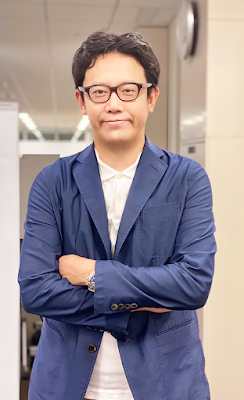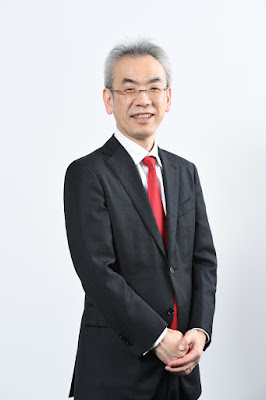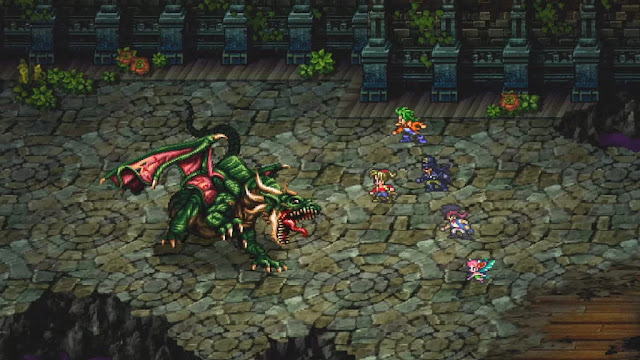Interview by Matt S.
For many years now, the SaGa series has sat quietly behind Square Enix’s giant JRPG properties – Final Fantasy, Dragon Quest, Mana, and even Star Ocean. And yet while those properties seem to get all the attention, SaGa has been kicking along in the background, slowly building up a niche audience of people who realise that there is a lot of merit to this series.
The end of 2019 is a big time for the series, too. Just a couple of weeks ago Romancing SaGa 3 was remastered and released in English for the first time (officially). It hasn’t turned too many heads among critics, or generated too many reviews, but those who have actually played it have found it to be quite remarkable. Then, next month, a new chapter of the SaGa series arrives with a port of the PlayStation Vita original SaGa Scarlet Grace: Ambitions… and that game looks really, really good.
I recently had the chance to sit down with Ichikawa Masanori (SaGa series producer) and Kawazu Akitoshi (Saga series director) to discuss the vision they have for the series, the value of bringing Romancing SaGa 3 to English for the first time, and why the series has never quite achieved the profile of its brethren, despite being of an equivalent standard.
Matt S: What do you think it is about Romancing SaGa 3 that will still appeal to modern audiences in 2019?
Masanori I – One day in 1989, while I was fishing in a seaside town and waiting for a fish to bite, I was playing The Final Fantasy Legend on my Game Boy. That was my first experience with the SaGa series (back then, for a number of reasons, this game ended up being marketed outside of Japan as The Final Fantasy Legend but it was actually part of the SaGa series. There were three games released under this title). From that point forward, for the past 30 years, I’ve been a fervent devotee to this series and all of its charms.
Many fans of the SaGa series in Japan have had similar experiences and many have, like me, fallen under its spell. I think that’s the reason that the SaGa series has such longevity – it’s not just some passing, fad of a game that everyone happens to be playing right now. Players the world over – not just in Japan – are always looking for experiences that are different and new.
Akitoshi K: I see two possible answers to your question:
Firstly, each entry within the SaGa series – from the original The Final Fantasy Legend to the upcoming release of SaGa Scarlet Grace: Ambitions – has always tried something new. I believe that reason – the ‘something new’ in each individual game – has continuously given players a powerful gameplay experience.
Secondly, the combination of a high level of player freedom afforded by the open scenario structure of the game alongside the incredibly difficult battles makes for an intense experience!! I think the intensity of this experience makes it one that players aren’t quick to forget. At least, this was true for me.
Matt S: Audiences will get the chance to directly compare “then-and-now” when SaGa Scarlet Grace: Ambitions also releases soon after. Looking over the SaGa series, how would you say it has changed and matured over the years?
Akitoshi K – Romancing SaGa 3 was a game originally for the SNES, and all art was made on 8×8 cells. The game size clocked in at just 4 MB. In comparison, SaGa Scarlet Grace: Ambitions can be played on PS4, Switch, and more. It uses 3D CG, and the size is well over 4 GB.
This is in part to do with technological progress, but it’s also to do with the fact that the world of games itself has changed. In 1994, when the original Romancing SaGa 3 came out, the number of games released in the entirety of that year is the number of games now released in under a week. That’s how common video games have become.
Amidst all that change, the basic concept behind the SaGa series remains the same. It’s a game for people who really like JRPGs. Every installation of the SaGa series also implements a highly original game system, and in an era in which new games are constantly being announced, this is more necessary than ever. SaGa Scarlet Grace: Ambitions is no exception.
 |
| Ichikawa Masanori |
Matt S: Square Enix has a lot of JRPG properties. What do you think it is about SaGa as a series that differentiates itself from other series, for example Final Fantasy, Dragon Quest, Mana, and so on?
Masanori I – I can only speak about this from the point of view of a producer. I think that the most distinctive feature of the SaGa series is that each title is created while fully considering what the core of what an RPG is, and what makes it fun to play. I would hazard a guess that this is because, as Akitoshi Kawazu (the SaGa Series Director) has said in a lot of interviews, Dungeons & Dragons was a very intense gameplay experience for him.
When playing games in the SaGa series, it’s as though you’ve really strapped a backpack onto your shoulders and have set out on a journey. The player is free to make their own choices in the truest sense, be it, “I’ll go there and defeat that enemy. No, actually, I’ll go over there and get that item instead,” or considering, “how can I possibly fulfill that request?” which really makes them feel like they themselves are a character in the story. Of course, you can feel this kind of experience while playing both Romancing SaGa 3 and SaGa Scarlet Grace: Ambitions.
While this is a word that really isn’t very commonly used in Japan, I’ve heard that this in-game story experience is referred to as “narrative” in Europe and the Americas. This is something that SaGa series fans in Japan have been experiencing for since the original release of Romancing SaGa 3 24 years ago.
I don’t think most players in Japan compare the SaGa series with our other titles or other companies’ JRPGs before choosing it. I think that they choose the genre that is ‘SaGa’.
Matt S: What are the key narrative themes that we’ll experience in each game? Why did you think these themes were important when developing these games?
Akitoshi K – Romancing SaGa 3 features eight different characters who have all experienced the same incident and all have their own feelings about it, and who then go on to follow their own paths. In the course of this journey, they may meet again, or they may continue their adventure with a new group of friends. This itself was a technique to help realise the premise of saving the world, while allowing the player to make choices freely as the main character.
SaGa Scarlet Grace: Ambitions is a tale of unraveling the truth about the being known as the Wicked One. The truth of the Wicked One is, so to speak, the truth of the world, and the truth of the world is a thing that varies based on how people approach it. This game focuses on how each of the main characters confront and come face to face with the world, and by extension, themselves. I wanted to make sure that the diversity of modern society was expressed in the world of the game.
Matt S: Remakes of classic games are difficult – on the one hand it’s important to remain true to the source, but on the other the game needs to appeal to modern players too. How has the team approached that delicate balancing act in Romancing SaGa 3?
Masanori I – The flip side of the freedom afforded by the SaGa series is that some users find it inaccessible, so for the remastered version of Romancing SaGa 3 we sought help from ArtePiazza, who are known for easy to understand, well-loved games like the aforementioned Dragon Quest
When I play old games these days, I would prefer the full screen experience to the small, square, centred screen that displays on modern equipment (although there are some titles I prefer to play just as they were!)
I love pixel art, which is why for the remastered version, we re-illustrated the backgrounds, but kept the characters in pixel art form. The bosses and mini bosses are pixel art as well, although we made them move more smoothly to give them extra impact.
I truly believe that the original version of Romancing SaGa 3 was a masterpiece, and consequently, I imagine that there are lots of people who want to play the game just as it is, with nothing added. That’s why there’s an option at the very beginning of the game to choose between playing with or without added material.
 |
| Kawazu Akitoshi |
However, this time around, we were missing a lot of the original resources that were available to us when we created the Romancing SaGa 2 remaster in 2016 and we had to recreate a lot of things. This was especially true of the mini-game and battle elements. We compared all of the pieces to the original SNES version one element at a time and fixed the differences as necessary.
I sometimes see TV shows where they take a rusty old car, clean it up beautifully and make it roadworthy again. That’s the same basic idea.
Matt S: You’ve been working on JRPGs from right back at the formation of the genre. How would you say expectations and approaches to the genre have changed over the years?
Akitoshi K – Firstly, I think the ability to enjoy the game over a long period of time is an important part of JRPGs. The much longer play time when compared to other game genres, such as action or shooting games, is a great advantage, and this is something that’s still true today.
The opportunity to dig in to a story or a character is another appealing part of the JRPG genre. I think that character creation, and also including the great visuals, is still one of the greatest strengths of the JRPG genre.
I find that game systems in general are rarely changed and should be approached as something to question and try to improve. In a sense, the story and the characters are just a skin, and if the essence of the game itself remains unchanged, players will grow bored.
Matt S: Given the success of Octopath Traveler and some of these remakes, do you feel like there’s a significant push back towards the retro, in terms of what players want to see in their JRPGs?
Masanori I – I personally understand the appeal of retro games, but our approach to Romancing SaGa 3 was somewhat different than the usual approach to a retro game. I consider Romancing SaGa 3 to be a masterpiece, and I believe that masterpieces must be preserved.
Even if resources are missing, no matter how much longer development takes than it did for the original, it’s a game worth bringing back to life, and it must be kept from fading into the obscurity of history. This is my mission, and I think that this remastered version has accomplished it.
As the SaGa series producer, I don’t think about whether or not the game is retro. Rather, I’m constantly thinking about what we can do to give players a new RPG experience, and how to present the creations of Akitoshi Kawazu and the SaGa series dev team to them.
Making sure that they have a chance to experience Romancing SaGa 3, which has, for some, been kept from the light of day for 24 years, is one way of doing this.
Another way is doing the same with the most recent title, SaGa Scarlet Grace: Ambitions. We were able to achieve this goal in Japan last year. To the rest of the world, we’re sorry it’s taken so long!
Matt S: What is your long-term vision for the SaGa series?
Masanori I – A famous Japanese game music composer once told me, “Truly great songs are fully appreciated with the passage of time. One of my songs which was originally a B-side has recently come back around and is now a huge hit.” I see the SaGa series as the same sort of thing.
When I was in school, I was a SaGa fan, and it bothered me that even in Japan, it was less in the spotlight than other game series. I really wanted to do something about it. However, it’s not as though I tried to force the SaGa series back into popularity. That’s not the kind of producer I am.
If you look at all of the excitement surrounding the SaGa series, it’s clear that the fans are giving it the recognition it deserves and have just been waiting for the series to make its comeback. The release of the remastered version of Romancing SaGa 2 in 2016 was the beginning, followed by Mr. Kawazu’s newest work, SaGa Scarlet Grace: Ambitions. It was the recognition and acceptance afforded it by the fans that got us to where we are today.
I feel sorry for the game fans everywhere that the SaGa series is not available to play the world over. I feel that it’s my mission to ensure that the SaGa series can be played anywhere, at any time, on the most current hardware and platforms. It’s only available in English right now, but someday, we would like to be able to make it available in a variety of languages. Not to mention bringing fans the next thing Mr. Kawazu and the SaGa series dev team have in mind. That’s my long-term vision.
I’m not the sort of producer to strong-arm things, so I want to hear from everyone. Whatever your feedback, be it that the game is fascinating or boring, I want to know. Try the SaGa series for yourself and tell me – on Twitter or anywhere else – what you honestly thought. This is what motivates both me and the rest of the SaGa series team to keep going.
Matt S: The story of how Final Fantasy was developed is well know at this point – yourself and the team were inspired by Dungeons & Dragons and wanted to stay true to that for a Japanese game. Looking at the JRPG genre now, it has grown into its own thing and no longer closely resembles Dungeons & Dragons. Have you ever wanted to go back and perhaps create a new game in the vision of Dungeons & Dragons?
Kawazu – I’m constantly trying to recreate the elements and feel of tabletop RPGs within video games. This is completely different to what most JRPGs are going for, so the obvious result of this is that the resulting game ends up being very different.
There are lots of elements of tabletop RPGs that make them fun and interesting, and I want to keep looking for ways to incorporate them into JRPG videogames.
Matt S: Finally, when you’re not busy making games, what do you like to play?
Masanori I – I play games with my 4 and 7-year-old sons. Those are some of the happiest times for me!
– Matt S.
Editor-in-Chief
Find me on Twitter: @digitallydownld












